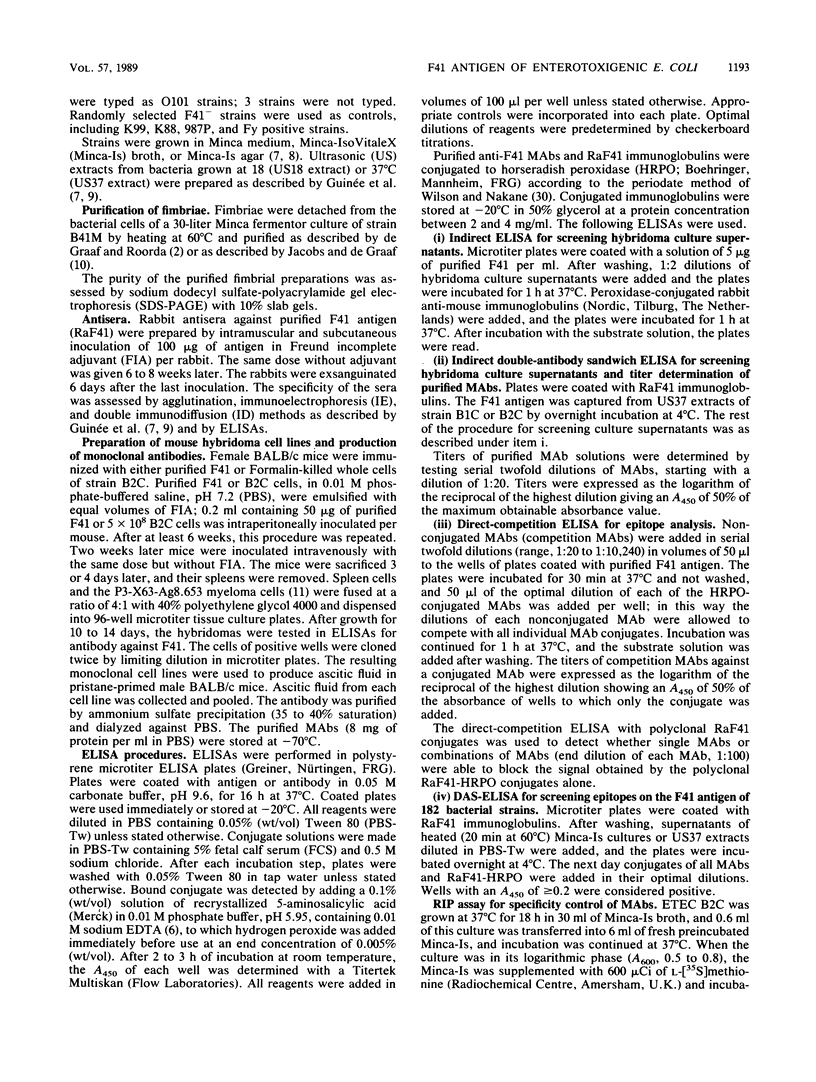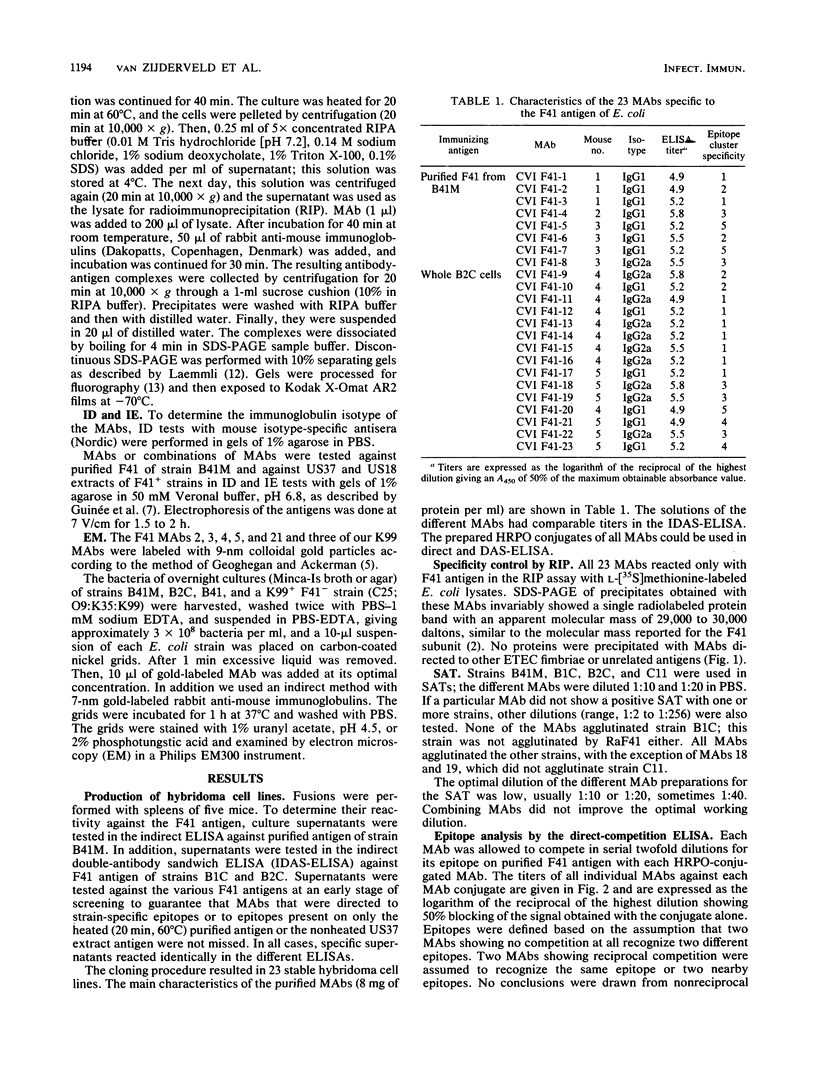Abstract
We produced monoclonal antibodies (MAbs) from 23 different murine hybridoma cell lines against the F41 fimbrial antigen of bovine and porcine enterotoxigenic Escherichia coli. Cell lines were created by fusing myeloma cells and spleen cells of mice that were immunized with either purified F41 or with Formalin-killed whole cells. The specificity of the MAbs to the F41 antigen was proven by enzyme-linked immunosorbent assays (ELISAs) and radioimmunoprecipitation tests. Epitope analysis with a competition ELISA revealed that the 23 MAbs recognized at least five epitopes. These results were corroborated by those of immunodiffusion tests, in which all possible combinations of two MAbs were tested against ultrasonically disintegrated F41 antigen. In a double-antibody sandwich ELISA, all peroxidase-conjugated MAbs bound to the F41 antigen of all 182 bacterial strains that were tested. Apparently, the epitopes recognized by the MAbs are highly conserved. Immunoelectron microscopy revealed that the MAbs were directed to fimbrial structures 3 to 4 nm in diameter and that the epitopes were equally distributed along the fimbriae. Consequences for the replacement of polyclonal antisera by MAbs in diagnostic tests are discussed. The results of the radioimmunoprecipitation assay suggested that F41 fimbriae are composed of a single repeating 29,000-dalton protein subunit; however, we could not exclude the possibility of the existence of minor fimbrial components.
Full text
PDF







Images in this article
Selected References
These references are in PubMed. This may not be the complete list of references from this article.
- Abraham S. N., Goguen J. D., Sun D., Klemm P., Beachey E. H. Identification of two ancillary subunits of Escherichia coli type 1 fimbriae by using antibodies against synthetic oligopeptides of fim gene products. J Bacteriol. 1987 Dec;169(12):5530–5536. doi: 10.1128/jb.169.12.5530-5536.1987. [DOI] [PMC free article] [PubMed] [Google Scholar]
- Gaastra W., de Graaf F. K. Host-specific fimbrial adhesins of noninvasive enterotoxigenic Escherichia coli strains. Microbiol Rev. 1982 Jun;46(2):129–161. doi: 10.1128/mr.46.2.129-161.1982. [DOI] [PMC free article] [PubMed] [Google Scholar]
- Geoghegan W. D., Ackerman G. A. Adsorption of horseradish peroxidase, ovomucoid and anti-immunoglobulin to colloidal gold for the indirect detection of concanavalin A, wheat germ agglutinin and goat anti-human immunoglobulin G on cell surfaces at the electron microscopic level: a new method, theory and application. J Histochem Cytochem. 1977 Nov;25(11):1187–1200. doi: 10.1177/25.11.21217. [DOI] [PubMed] [Google Scholar]
- Guinée P. A., Jansen W. H., Agterberg C. M. Detection of the K99 antigen by means of agglutination and immunoelectrophoresis in Escherichia coli isolates from calves and its correlation with entertoxigenicity. Infect Immun. 1976 May;13(5):1369–1377. doi: 10.1128/iai.13.5.1369-1377.1976. [DOI] [PMC free article] [PubMed] [Google Scholar]
- Guinée P. A., Jansen W. H. Behavior of Escherichia coli K antigens K88ab, K88ac, and K88ad in immunoelectrophoresis, double diffusion, and hemagglutination. Infect Immun. 1979 Mar;23(3):700–705. doi: 10.1128/iai.23.3.700-705.1979. [DOI] [PMC free article] [PubMed] [Google Scholar]
- Guinée P. A., Veldkamp J., Jansen W. H. Improved minca medium for the detection of K99 antigen in calf enterotoxigenic strains of Escherichia coli. Infect Immun. 1977 Feb;15(2):676–678. doi: 10.1128/iai.15.2.676-678.1977. [DOI] [PMC free article] [PubMed] [Google Scholar]
- Kearney J. F., Radbruch A., Liesegang B., Rajewsky K. A new mouse myeloma cell line that has lost immunoglobulin expression but permits the construction of antibody-secreting hybrid cell lines. J Immunol. 1979 Oct;123(4):1548–1550. [PubMed] [Google Scholar]
- Laemmli U. K. Cleavage of structural proteins during the assembly of the head of bacteriophage T4. Nature. 1970 Aug 15;227(5259):680–685. doi: 10.1038/227680a0. [DOI] [PubMed] [Google Scholar]
- Laskey R. A., Mills A. D. Quantitative film detection of 3H and 14C in polyacrylamide gels by fluorography. Eur J Biochem. 1975 Aug 15;56(2):335–341. doi: 10.1111/j.1432-1033.1975.tb02238.x. [DOI] [PubMed] [Google Scholar]
- Lindberg F., Lund B., Normark S. Gene products specifying adhesion of uropathogenic Escherichia coli are minor components of pili. Proc Natl Acad Sci U S A. 1986 Mar;83(6):1891–1895. doi: 10.1073/pnas.83.6.1891. [DOI] [PMC free article] [PubMed] [Google Scholar]
- Mainil J. G., Moseley S. L., Schneider R. A., Sutch K., Casey T. A., Moon H. W. Hybridization of bovine Escherichia coli isolates with gene probes for four enterotoxins (STaP, STaH, STb, LT) and one adhesion factor (K99). Am J Vet Res. 1986 May;47(5):1145–1148. [PubMed] [Google Scholar]
- Moch T., Hoschützky H., Hacker J., Kröncke K. D., Jann K. Isolation and characterization of the alpha-sialyl-beta-2,3-galactosyl-specific adhesin from fimbriated Escherichia coli. Proc Natl Acad Sci U S A. 1987 May;84(10):3462–3466. doi: 10.1073/pnas.84.10.3462. [DOI] [PMC free article] [PubMed] [Google Scholar]
- Mooi F. R., van Buuren M., Koopman G., Roosendaal B., de Graaf F. K. K88ab gene of Escherichia coli encodes a fimbria-like protein distinct from the K88ab fimbrial adhesin. J Bacteriol. 1984 Aug;159(2):482–487. doi: 10.1128/jb.159.2.482-487.1984. [DOI] [PMC free article] [PubMed] [Google Scholar]
- Morris J. A., Stevens A. E., Sojka W. J. Anionic and cationic components of the K99 surface antigen from Escherichia coli B41. J Gen Microbiol. 1978 Jul;107(1):173–175. doi: 10.1099/00221287-107-1-173. [DOI] [PubMed] [Google Scholar]
- Morris J. A., Thorns C. J., Sojka W. J. Evidence for two adhesive antigens on the K99 reference strain Escherichia coli B41. J Gen Microbiol. 1980 May;118(1):107–113. doi: 10.1099/00221287-118-1-107. [DOI] [PubMed] [Google Scholar]
- Morris J. A., Thorns C. J., Wells G. A., Scott A. C., Sojka W. J. The production of F41 fimbriae by piglet strains of enterotoxigenic Escherichia coli that lack K88, K99 and 987P fimbriae. J Gen Microbiol. 1983 Sep;129(9):2753–2759. doi: 10.1099/00221287-129-9-2753. [DOI] [PubMed] [Google Scholar]
- Morris J. A., Thorns C., Scott A. C., Sojka W. J., Wells G. A. Adhesion in vitro and in vivo associated with an adhesive antigen (F41) produced by a K99 mutant of the reference strain Escherichia coli B41. Infect Immun. 1982 Jun;36(3):1146–1153. doi: 10.1128/iai.36.3.1146-1153.1982. [DOI] [PMC free article] [PubMed] [Google Scholar]
- Morris J. A., Wells G. A., Scott A. C., Sojka W. J. A comparison of methods for demonstrating colonization in the small intestine of piglets by enterotoxigenic Escherichia coli. Br Vet J. 1985 Sep-Oct;141(5):484–489. doi: 10.1016/0007-1935(85)90043-0. [DOI] [PubMed] [Google Scholar]
- Moseley S. L., Dougan G., Schneider R. A., Moon H. W. Cloning of chromosomal DNA encoding the F41 adhesin of enterotoxigenic Escherichia coli and genetic homology between adhesins F41 and K88. J Bacteriol. 1986 Sep;167(3):799–804. doi: 10.1128/jb.167.3.799-804.1986. [DOI] [PMC free article] [PubMed] [Google Scholar]
- Orskov I., Orskov F. Serology of Escherichia coli fimbriae. Prog Allergy. 1983;33:80–105. [PubMed] [Google Scholar]
- Raybould T. J., Crouch C. F., Acres S. D. Monoclonal antibody passive hemagglutination and capture enzyme-linked immunosorbent assays for direct detection and quantitation of F41 and K99 fimbrial antigens in enterotoxigenic Escherichia coli. J Clin Microbiol. 1987 Feb;25(2):278–284. doi: 10.1128/jcm.25.2.278-284.1987. [DOI] [PMC free article] [PubMed] [Google Scholar]
- Sherman D. M., Acres S. D., Sadowski P. L., Springer J. A., Bray B., Raybould T. J., Muscoplat C. C. Protection of calves against fatal enteric colibacillosis by orally administered Escherichia coli K99-specific monoclonal antibody. Infect Immun. 1983 Nov;42(2):653–658. doi: 10.1128/iai.42.2.653-658.1983. [DOI] [PMC free article] [PubMed] [Google Scholar]
- To S. C. F41 antigen among porcine enterotoxigenic Escherichia coli strains lacking K88, K99, and 987P pili. Infect Immun. 1984 Feb;43(2):549–554. doi: 10.1128/iai.43.2.549-554.1984. [DOI] [PMC free article] [PubMed] [Google Scholar]
- Zschöck M., Semler B., Weiss R. Vergleichende Untersuchungen zum direkten Nachweis von K99-Antigen in Kälberkotproben unter besonderer Berücksichtigung der Latex-Agglutinationstechnik. Zentralbl Veterinarmed B. 1986 Dec;33(10):762–770. [PubMed] [Google Scholar]
- de Graaf F. K., Roorda I. Production, purification, and characterization of the fimbrial adhesive antigen F41 isolated from calf enteropathogenic Escherichia coli strain B41M. Infect Immun. 1982 May;36(2):751–758. doi: 10.1128/iai.36.2.751-758.1982. [DOI] [PMC free article] [PubMed] [Google Scholar]
- van Zijderveld F. G., Overdijk E. Experiences with the ELISA for detection of the E. coli K99 antigen in calf faeces. Ann Rech Vet. 1983;14(4):395–399. [PubMed] [Google Scholar]




